A process-oriented approach for identifying potential landslides considering time-dependent behaviors beyond geomorphological features
Xing Sun,Guoqing Chen,*,Xing Yng,Zhengxun Xu,Jingxi Yng,Zhiheng Lin,Yunpeng Liu
a State Key Laboratory of Geohazard Prevention and Geoenvironment Protection, Chengdu University of Technology, Chengdu, 610059, China
b China Railway Eryuan Engineering Group Co.Ltd., Chengdu, 610031, China
c Power China Chengdu Engineering Co.Ltd., Chengdu, 610072, China
Keywords: Geomorphological features Evolution history Time-dependent stability calculation Landslides identification Qinghai-Tibet Plateau
ABSTRACT Geomorphological features are commonly used to identify potential landslides.Nevertheless,overemphasis on these features could lead to misjudgment.This research proposes a process-oriented approach for potential landslide identification that considers time-dependent behaviors.The method integrates comprehensive remote sensing and geological analysis to qualitatively assess slope stability,and employs numerical analysis to quantitatively calculate aging stability.Specifically,a time-dependent stability calculation method for anticlinal slopes is developed and implemented in discrete element software,incorporating time-dependent mechanical and strength reduction calculations.By considering the time-dependent evolution of slopes,this method highlights the importance of both geomorphological features and time-dependent behaviors in landslide identification.This method has been applied to the Jiarishan slope (JRS) on the Qinghai-Tibet Plateau as a case study.The results show that the JRS,despite having landslide geomorphology,is a stable slope,highlighting the risk of misjudgment when relying solely on geomorphological features.This work provides insights into the geomorphological characterization and evolution history of the JRS and offers valuable guidance for studying slopes with similar landslide geomorphology.Furthermore,the process-oriented method incorporating timedependent evolution provides a means to evaluate potential landslides,reducing misjudgment due to excessive reliance on geomorphological features.
1.Introduction
The Qinghai-Tibet Plateau has experienced continuous uplift and compressional structural deformation since the Cenozoic Era due to the ongoing compression of the Indian and Eurasian plates.This region exhibits complex topography and geomorphology(Yang et al.,2016;Zhang et al.,2016),active plate tectonics(Tapponnier and Molnar,1977;Zhang et al.,2004;Cai et al.,2016;Ding et al.,2017),high seismic intensity (Xu et al.,2016),and prevalent mountain disasters(Cui et al.,2015).The development of geological hazards on the Qinghai-Tibet Plateau is influenced by the dynamic coupling of plate compression,plateau uplift,climate change,and engineering forces.This interaction results in a high density of geological hazards with significant damage (Huang,2012).Typical geological hazards include the Yigong landslide in Bomi County,Tibet,in 2000(Shang et al.,2003),the Xinmo Village landslide in Maoxian County in 2017(Fan et al.,2017;Intrieri et al.,2018),and the Baige landslide in Jiangda County,Tibet,in 2018(Cai et al.,2020).These geological hazards often cause a series of disaster chains(Fan et al.,2021;Wang et al.,2021).Current research on major geological topics of the Qinghai-Tibet Plateau mainly focuses on large-scale landslides and debris flows(Lu and Cai,2019),giant deposits of complex origin,ultra-large rock debris slopes,plateau ice and snow disasters (Kuang and Jiao,2016;Niu et al.,2016;Zhang et al.,2020),high-temperature heat damage (Guo et al.,2017;Jiang et al.,2019;Mao et al.,2021),high in situ stress(Wang et al.,2020),and plateau karst(Sun et al.,2016).In particular,extensive research has been conducted on the geological conditions,formation mechanisms,and prevention measures of various geological hazards that occur in the region(Shang et al.,2003;Fan et al.,2017;Cai et al.,2020;Wang et al.,2023).However,there is relatively less research focused on potential hazards that do not yet occur.Nevertheless,recognizing the early signs of potential hazards and implementing preventive measures to avoid major engineering projects intersecting with slopes prone to deformation can significantly mitigate the impact of geological hazards on such projects(Ji et al.,2020;Prakash et al.,2020).
In early recognition,optical remote sensing is the most commonly used technology(Metternicht et al.,2005;Nichol et al.,2006).In recent years,interferometric synthetic aperture radar(InSAR),light detection and ranging (LiDAR),laser doppler vibrometer terrestrial laser scanning (TLS),and unmanned aerial vehicle(UAV)have also been used for geohazard identification and have been rapidly developed(Ferretti et al.,2000;Berardino et al.,2002;Zhang et al.,2012;Hsieh et al.,2016;Mateos et al.,2017;Jia et al.,2019;Li et al.,2020;Xie et al.,2022).When employing these methods for landslide identification,geomorphological features are typically the primary criterion for assessing whether a slope has the potential for landslides.However,relying solely on geomorphological features to determine the potential for landslides can lead to a high possibility of misjudgment in the complex geological context of the Qinghai-Tibet Plateau.Therefore,additional engineering geological surveys and analysis of the slope’s evolutionary history are necessary.It is important to acknowledge that even a stable slope may exhibit landforms resembling landslides,and this possibility cannot be ignored (Scaioni et al.,2014;Fan et al.,2017;Intrieri et al.,2018;Ouyang et al.,2018;Li et al.,2019).
In the Jinsha River basin on the Qinghai-Tibet Plateau,there is a recently constructed tunnel known as the Jiarishan tunnel,with an associated slope at the tunnel entrance referred to as the Jiarishan slope(JRS).Based on satellite remote sensing data,the trailing edge of the JRS exhibits a circular chair-shaped landform,resembling the scarp of a landslide.Considering that the slope is anti-dip in nature,there is a possibility of toppling deformation and instability (Guo et al.,2020).In order to overcome the limitations of relying solely on geomorphological features for landslide identification,a process-oriented method considering time-dependent evolution is applied to assessing the potential landslide status of the JRS in this study.The application of this method reveals that the JRS,despite exhibiting landslide geomorphology,is considered as a stable antidip slope.This highlights the importance of considering timedependent evolution in the assessment of potential landslides,as it provides a more comprehensive understanding of slope stability.This work provides insights into the slope geomorphology and evolution history of the JRS as well as useful inspiration for the study of other slopes with similar landslide geomorphology in the Qinghai-Tibetan Plateau.Furthermore,the proposed processoriented method,which takes into account time-dependent evolution,provides a valuable approach for evaluating the potential of a slope to experience landslides.
2.Study area and geological settings
The JRS is situated in Baiyu County,located in the Qinghai-Tibet Plateau of China.It is part of the Jinsha River fault system,as depicted in Fig.1a and b.The Jinsha River fault system,situated on the eastern margin of the Qinghai-Tibetan Plateau,is characterized by complex geological structures.The formation of the Qinghai-Tibetan Plateau occurred around 70 million years ago as a result of the collision between the Indian and Eurasian plates.This collision led to crustal shortening and the development of thrusts and deformations in the collision zone during the Eocene period.The tectonic activity in the eastern region of the Jinsha River fault system resulted in the formation of the Songpan-Ganzi trough fold and fault system,while the western region gave rise to the Sanjiang trough fold system.
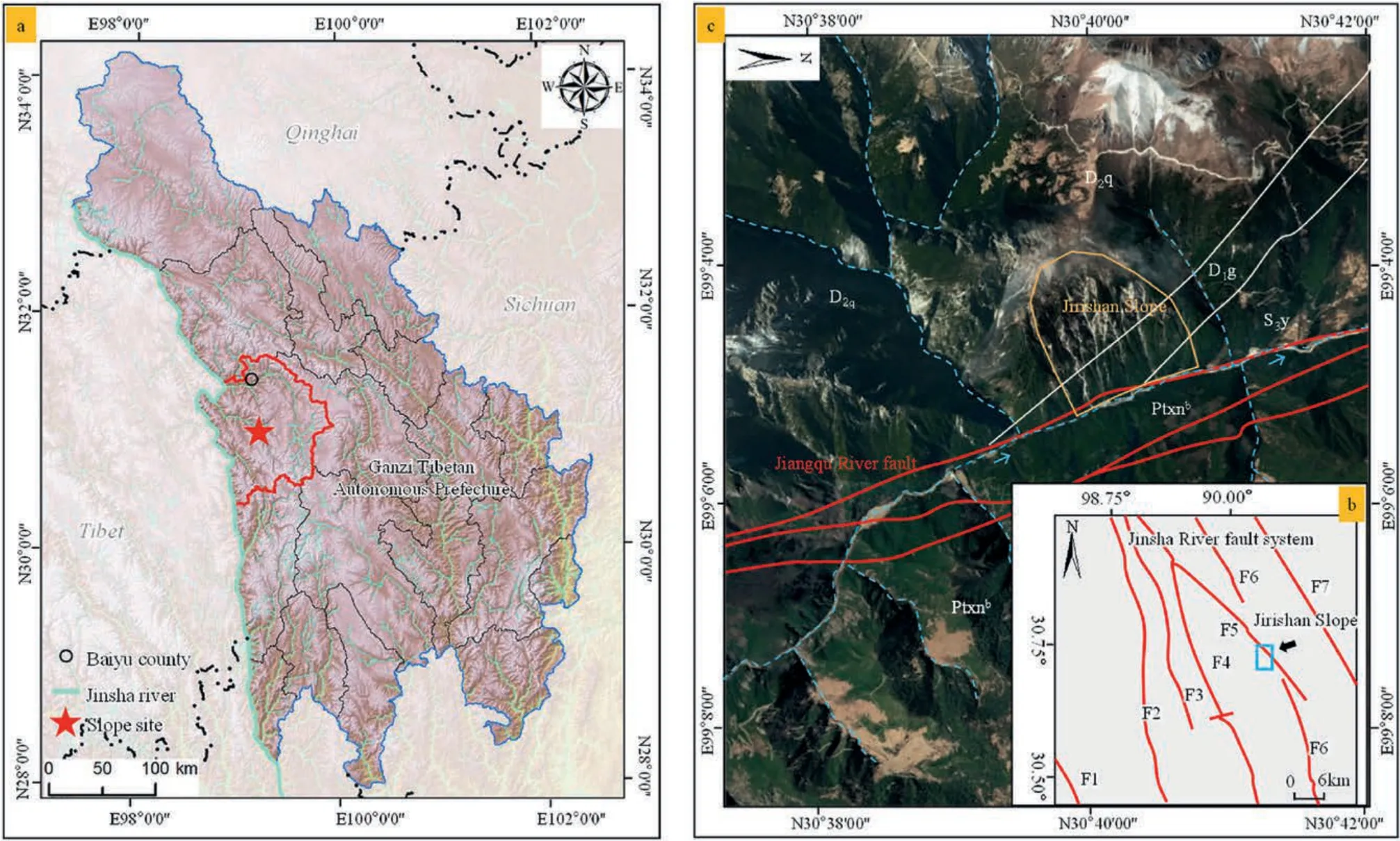
Fig.1.(a) Geographical location of the Jiarishan slope (JRS).(b) Geological settings of the Jinsha River fault system.(c) Geological settings of the JRS.
The near-field region is characterized by relatively developed fault structures.From west to east,the main faults in this area include the Shengen-Zhongmei fault (F1),Polo-Muxie fault (F2),Romer-Ani fault (F3),Zhuying-Shanyan fault (F4),Polo-Sama fault(i.e.Jiangqu River fault)(F5),Azuo-Rannei fault(F6),and Mount Ella fault(F7).Details on the occurrence,activity,and category of these faults can be found in Table 1.
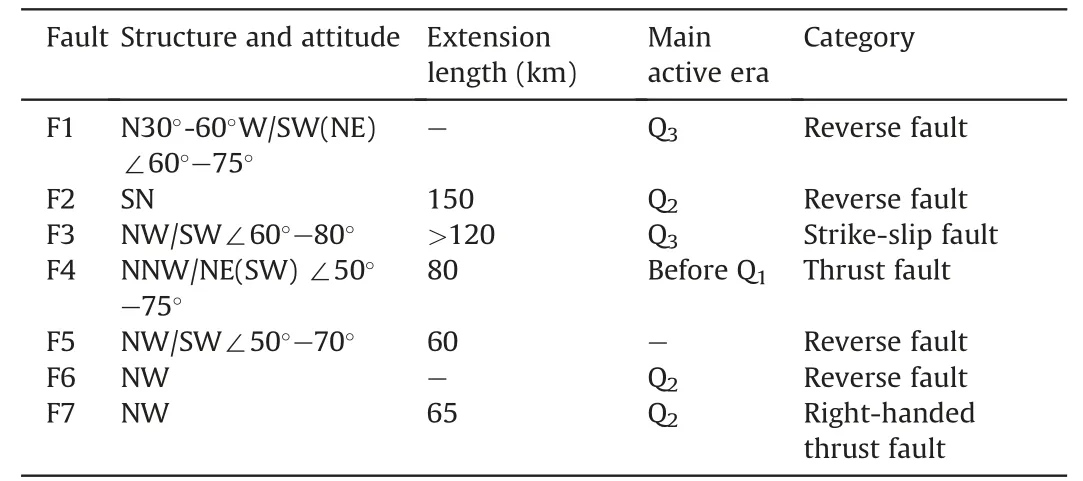
Table 1 The main faults and their properties in the JRS region.
Fig.1c depicts the geological context of the JRS.An NNWoriented fault (F5) with a length exceeding 120 km is presented along the Jiangqu River at the base of the slope.The fault strikes N20-30°W/SW and dips 55-70°SW.The fault zone has an approximate width of 100 m and follows the Daxinong-Jiangqu valley.It dips in southwest direction and is characterized by distinctive geomorphological features and inclinations ranging from 50°to 70°.The fault was active during the Early to Middle Pleistocene epoch,but showed a reduced activity since the Late Pleistocene.Quartz within the fault zone displays a simple morphology and does not exhibit well-developed crustal quartz formations.Eroded quartz (orange peel,scaly,and mossy quartz)constitutes 70%-90% of the quartz presented.ESR dating of fractured quartz yields an age of (37.1 ±3) million years.
The exposed slope strata primarily consist of black carbonaceous crystalline limestone,argillaceous dolomite,quartz shallow granulite with iron dolomite,and schist from the Silurian Yongren Formation (S3y).The limestone and dolomite are dense,hard,and relatively intact with individual layer thickness of 20-100 cm.Surface weathering imparts a grayish-white coloration and the rock mass is partially fragmented.Fractures predominantly occur along bedding planes and joints.Fault F5 locally disrupts the rock mass and dissolution cavities occasionally form at the intersection of syntectonic cracks and joint planes with widths of 50-120 cm,heights of 40-70 cm,and depths of 50-100 cm.The Devonian Gerong Formation (D1g) comprises massive light-yellow dolomite and dolomitic limestone that are dense,hard,and blocky with an intact appearance.The Devonian Qiongcuo Formation (D2q) contains thick-massive crystalline limestone,biological limestone,fine-grained dolomite,and dolomitic limestone with minor argillaceous limestone and shale.The limestone and dolomite are dense,hard,and relatively intact with individual layer thicknesses exceeding 50 cm.Slope residual overburdenoccurs above an elevation of 4418 m,while slope collapse overburdenoccurs below an elevation of 3600 m and primarily consists of gravelly soil with a thickness of 5-20 m.
3.Methods and materials
3.1.Methods
Considering that the use of remote sensing methods to identify potential landslides generally focuses on the geomorphological features of the slope,emphasis on the geomorphological features will sometimes lead to misjudgment.The purpose of rapid identification can be achieved using advanced technical means.Nevertheless,conventional geological tools such as field-based geological surveys,rock mass structure surveys and geological history analysis can also be used.Then,a process-oriented method considering time-dependent evolution for potential landslide identification is established.The process includes comprehensive remote sensing identification,comprehensive geological identification and numerical analysis,as shown in Fig.2.

Fig.2.The process-oriented method considers time-dependent evolution to evaluate whether a slope is a potential landslide.
The proposed process-oriented method for potential landslide identification encompasses the following steps:
(1) Comprehensive remote sensing is used to initially determine whether the slope is potentially stable;
(2) The possible potential failure modes combined with the geomorphological features and stratigraphic lithology are listed;
(3) Comprehensive geology is used to further determine whether the slope is a potential landslide;
(4) Numerical analysis is used to calculate the time-dependent evolution process and the aging stability of slopes;
(5) A comprehensive determination is made concerning the potential for a slope that may experience landslides by integrating the results obtained from the remote sensing analysis,comprehensive geological investigations,and numerical analysis.
By considering both qualitative and quantitative factors,a more accurate assessment of the slope’s potential as a landslide can be obtained.The method can avoid the shortcomings of remote sensing methods that focus on geomorphic features and ignore geological history,geological conditions,and rock mass structure.The method aims to reduce the rate of misjudgment caused by an excessive reliance on geomorphological features.
3.1.1.Comprehensive remote sensing for preliminary judgment of stability
Comprehensive remote sensing includes analyzing the current landform characteristics and landform zoning using UAV,comparing the evolution of historical landforms using remote sensing images of historical sequences,analyzing the trend of surface deformation,and judging the surface deformation quantitatively using InSAR.By integrating UAV,remote sensing and InSAR data,a comprehensive preliminary judgment can be made.
Satellite-based synthetic aperture radars (SARs) commonly employ C-,X-,and L-band sensors.This study utilizes data from the European Space Agency(ESA)’s Sentinel-1 satellite,which carries a C-band sensor with a wavelength of 5.6 cm.The SAR data set comprises over 50 phases of Sentinel-1 data,with ascending phase data fully covering the study area.Data were acquired between November 2017 and November 2020 and processed using the Satellite-Based Augmentation System Small Baseline Subset(SBASInSAR) technique.Remote sensing image data were obtained from Google Earth and GF-2 satellites for the period of 1985-2020.UAV data were collected in August 2020.
3.1.2.Comprehensive geology for further judgment of stability
Comprehensive geology involves utilizing the characteristics of rock mass structure obtained through field investigations to assess whether the potential failure mode has been established.Furthermore,it entails analyzing the process of geomorphic evolution and examining the geological evolution history to uncover the underlying factors responsible for the formation of the current geomorphology.By integrating information on rock mass structure and geological evolution history,a comprehensive geological judgment is made,providing a holistic understanding of the slope’s geological dynamics and landscape evolution.
On-site investigations were conducted to study the geomorphology of the ground and the rock mass structure inside the slope.Field mapping was performed using 1:1000-scale geological maps,a handheld global positioning system (GPS),a laser rangefinder,and a compass.Geophysical methods,including resistivity measurements,were employed to enhance the investigation.To gain insights into the material composition of specific geomorphic areas,four trial trenches and one adit were excavated.Field surveys were conducted using GPS,laser rangefinders,and compasses to accurately determine the spatial distribution,orientation,and size of prominent landforms,as well as to identify signs of toppling failure along the slope.Resistivity measurements played a crucial role in identifying distinctive landforms such as scarps and karst formations.The trial trenches provided valuable information concerning the material composition of specific geomorphic areas,while the adit allowed for a detailed examination of signs of toppling failure from the surface to the interior of the slope.
3.1.3.Strain-softening aging intrinsic model for time-dependent mechanical calculation
The strain-softening model is concatenated with the Burgers model to form the strain-softening aging intrinsic model capable of simulating the viscoelastic-plastic behavior of the material.It considers the rock mass rheological properties and degradation properties during the downcutting process of valleys(Itasca,2005;Sun et al.,2023).The rheological equation corresponding to the strain-softening aging intrinsic model can be expressed as
where ε is the total strain,tis the time,σ is the stress,EMis the elastic modulus of Maxwell body,ηMis the viscosity coefficient of Maxwell body,EKis the elastic modulus of Kelvin body,ηKis the viscosity coefficient of Kelvin body,and εpis the strain of plastic body.
Kelvin,Maxwell,and plastic body contributions to stresses and strains are labeled using the superscripts K,M and P,respectively.Thus,the deviatoric behavior can be characterized by (Sun et al.,2023):
(1) Strain rate partitioning
(2) Kelvin body
(3) Maxwell body
(4) S-S model
whereeijis the deviator strain;is the deviator strain rate;Sijis the deviator stress;is the deviator stress rate;GMis the shear moduli of Maxwell body;GKis the shear moduli of Kelvin body;gis the plastic potential function;λ is the plastic multiplier;σ11,σ22and σ33are the maximum,intermediate and minimum principal stresses,respectively;andare the deviator strain rates of Kelvin,Maxwell,and plastic body,respectively.
In the strain-softening aging intrinsic model,the degradation process of strength parameters is expressed as a function related to plastic strain.The degradation of strength parameters including the cohesive force(c),the tensile strength(σt)and the angle of internal friction (φ) of material degrade in relation to corresponding increments in plastic strain:
where εptand εpsare the cumulative values of the tensile and shear plastic strain,respectively.
To simplify calculations,multi-section linear functions are frequently used to approximate the degradation of rock mass strength parameters.The degradation curve is shown in Fig.3.The numerical simulation incorporates the mechanical parameters of the rock mass obtained from a series of mechanical tests (see Table 2).For the stratification analysis,a conventional Coulomb slip model with area contact is adopted,which involves five key parameters: cohesion,angle of internal friction,tensile strength,normal stiffness(kn),and shear stiffness(ks).The normal stiffness is determined by(Cho et al.,2007)(see Table 3):
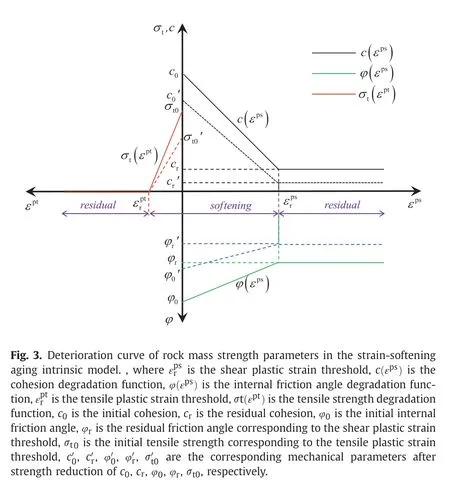
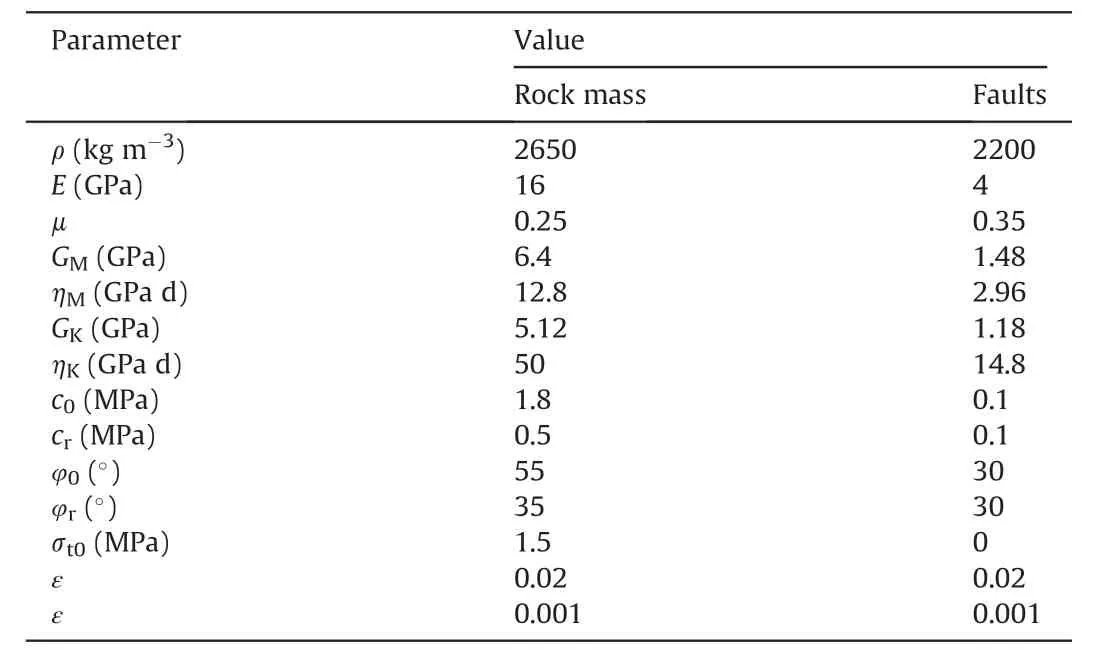
Table 2 The mechanical parameters of rock masses.

Table 3 The mechanical parameters of stratification.
where ΔZminis the minimum width of the area adjacent to the contact surface in vertical direction,nis the minimum size of the adjacent unit,Kis the bulk modulus,andGis the shear modulus.
The strain-softening aging intrinsic model employs the Mohr-Coulomb yield criterion to account for tensile-shear failure.The stress threshold (i.e.σr) is related to the plastic strain (i.e.εpsand εpt),allowing the yield criterion to be expressed as:
wherefsis the shear yield function;ftis the tensile yield function;and σ3and σ1are the maximum and minimum principal stress,respectively.The compressive stress is negative,and it is assumed that σ1≤σ3in the model.
3.1.4.Strength reduction method for aging stability calculation
Based on the time-dependent calculation,the stability of a slope with different creep times is calculated using the strength reduction method.This process is implemented in three-dimensional distinct element code (3DEC).As illustrated in Fig.3,strength reduction is done on an equal percentage basis.When the ratio of the maximum unbalance force at the differential nodes to the characteristic force of the system is greater than 10-5,the block system is considered unbalanced and the discount factor at this time represents the stability factor of the slope.The stability factor is defined in Eq.(9) when considering the influence of the joints(Chen et al.,2021):
where,Fsis the stability factor;Ksis the discount factor;cjis the cohesion of the joint;φjis the angle of internal friction of the joints;c′,φ′,,andare the cohesion of the rock mass,the angle of internal friction of the rock mass,the tensile strength of the rock mass,the cohesion of the joint,and the angle of internal friction of the joint after the plastic zone is exactly penetrated,respectively.
The process of evaluating the aging stability is as follows (see Fig.4):

Fig.4.Process of calculating the aging stability of slopes using the strength reduction method.
(1) Load the strain-softening aging intrinsic model,and define the boundary and initial conditions,and material parameters.
(2) Using the strain-softening aging intrinsic model,calculate the time-dependent mechanical behavior to obtain the stress,strain,plastic zone,and displacement characteristics of the slope at different creep times.
(3) In Step (2),the measured in situ stress data are used to compare with the stress data obtained from the simulation in order to discern the reasonableness of the calculated results in Step (2).Check whether the calculated results in step (2)are reasonable,and if not,repeat Steps (1),(2),and(3) until the results are reasonable and obtain the calculation results.
(4) Using the strength reduction method,the tensile strength,cohesion,and angle of internal friction of the rock mass,as well as the cohesion and angle of internal friction of the joints,are simultaneously reduced based on the calculation from Step(3).This reduction is performed on different strain states,as illustrated in Fig.3.
(5) Use a dichotomous method for strength reduction and stop calculations when a sliding surface forms from a penetrating damage zone to obtain the stability factor of slope.
(6) Obtain the location of the potential sliding surface of the slope and end the evaluation of aging stability.
3.2.Numerical model
In the numerical calculation,a model is established based on the engineering geological profile.The computational mesh is divided into three parts,i.e.slope rock mass,undercut part of the river valley,and fault.The model has dimensions of 2140 m in length and 2000 m in height.The rock strata are spaced 10 m apart and dip at an angle of 70°.The fault has a thickness of 15 m within the model.The initial shape of the model represents the river valley at the time of its first planation surface(see Fig.5),and the whole process from the first planation surface to the current valley is simulated through five sequential denudations and undercuts (Ning et al.,2021).The depth of each stage of excavation is determined according to the regional river terrace elevations,which are 4700 m,4200 m,3700 m,3270 m and 3220 m from the first planation surface to the current valley,respectively.After each stripping undercutting calculation confirms stability,further stripping undercutting is carried out.Once valley undercutting calculations are completed,aging stability calculations are performed.
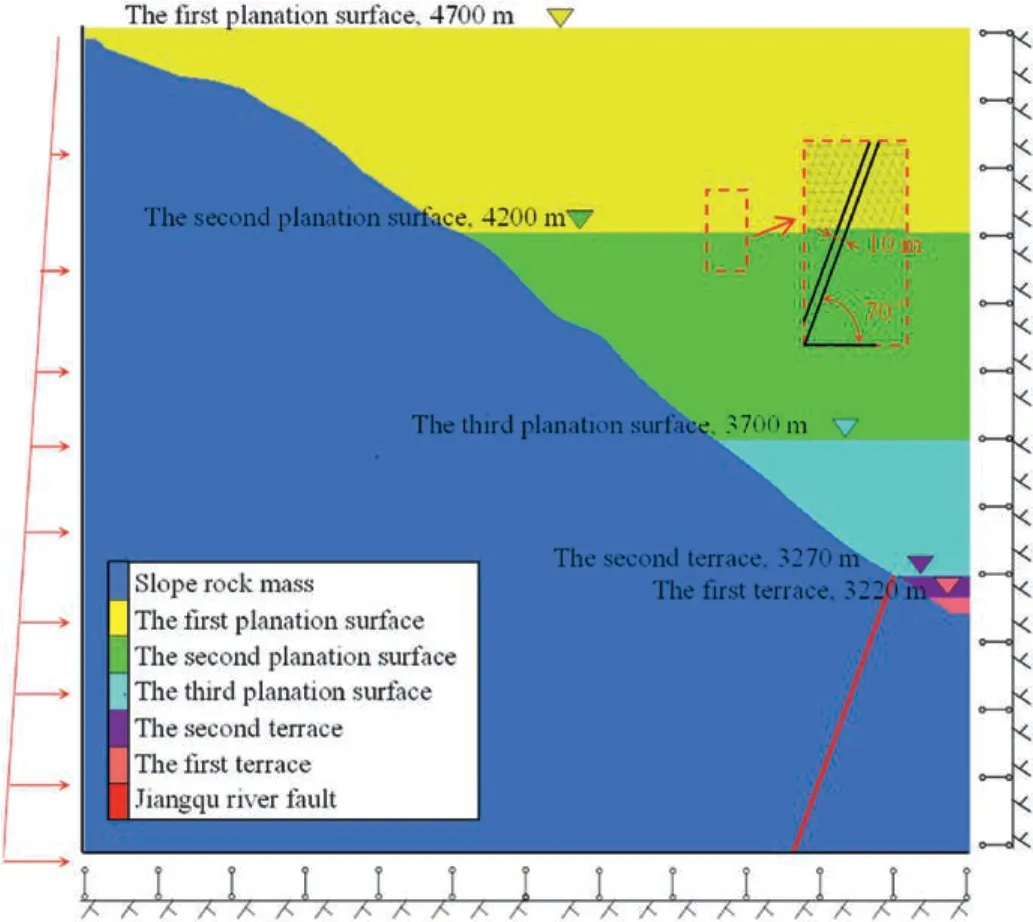
Fig.5.Geometrical model,computational mesh and boundary condition.
The boundary conditions consider the effects of both gravity and tectonic stress.Multiple simulations using different boundary condition models were conducted(Wang and Ma,1986;Zhao et al.,2012) (see Fig.6).The results revealed that the simulation data exhibited the closest match to the measured in situ stress data when vertical displacement and velocity constraints were enforced at the bottom of the model.The horizontal displacement and velocity constraints were imposed on the valley side of the model,and tectonic stress increased linearly with depth on the opposite side of the model (reaching 27 MPa at the bottom).
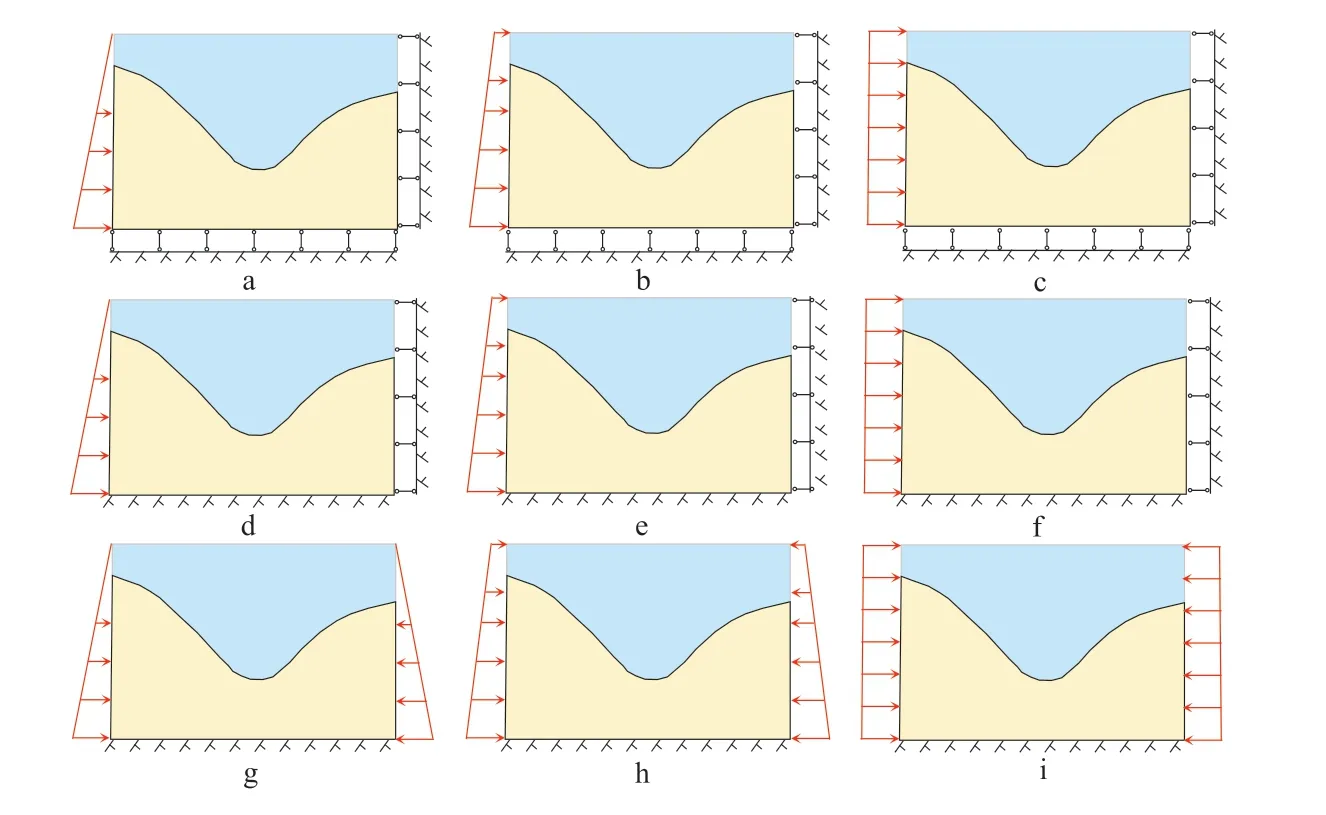
Fig.6.Models with different boundary conditions: (a)Roller bottom and unilateral triangular distributed stress boundary conditions;(b) Roller bottom and unilateral trapezoidal distributed stress boundary conditions;(c) Roller bottom and unilateral rectangular distributed stress boundary conditions;(d) Fixed bottom and unilateral triangular distributed stress boundary conditions;(e) Fixed bottom and unilateral trapezoidal distributed stress boundary conditions;(f) Fixed bottom and unilateral rectangular distributed stress boundary conditions;(g) Fixed bottom and lateral triangular distributed stress boundary conditions;(h) Fixed bottom and lateral trapezoidal distributed stress boundary conditions;and (i) Fixed bottom and lateral rectangular distributed stress boundary conditions.
4.Results
4.1.Preliminary judgment based on comprehensive remote sensing
4.1.1.Geomorphology zonation based on UAV
The chair-shaped JRS is clearly visible in the image shown in Fig.7.The elevation of the slope’s summit is approximately 4545 m,while the elevation at the base of the slope ranges from 3170 m to 3200 m.The total area of the slope covers approximately 9 km2.According to the deformation of the slope and the spatial distribution of karst,the JRS can be divided into three regions in plan view (see Fig.8a and b): the main deformation zone,karst zone,and superficial deformation zone.In the main deformation zone,there are multilevel scarps.The karst zone has a distribution of karst caves.The superficial deformation zone has some developed superficial slippery surfaces.The characteristics of these various parts will be discussed below.
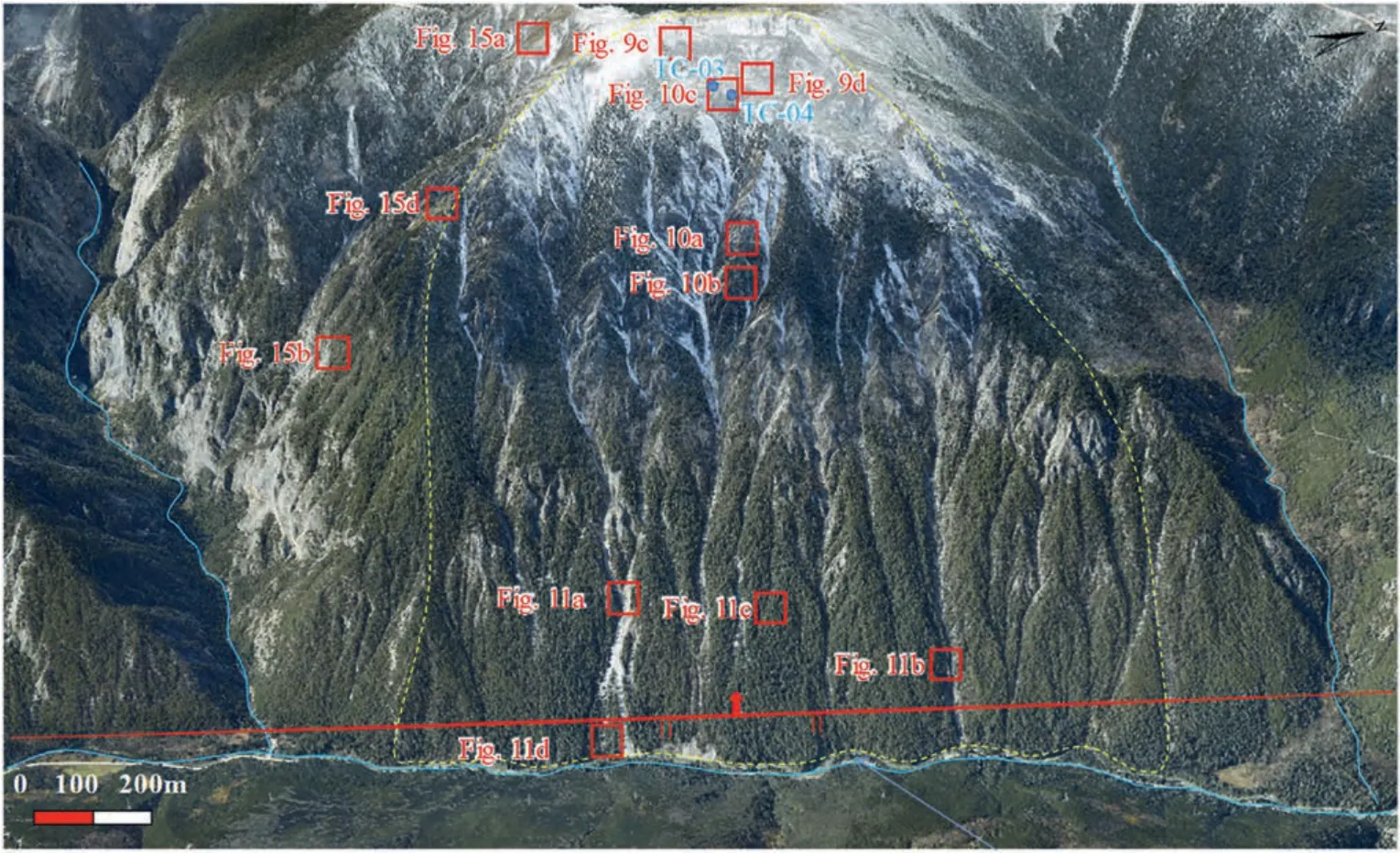
Fig.7.Image of the JRS depicting its plan zonation.

Fig.8.(a) Sketch of the JRS reflecting the distribution of the major surface landforms and (b) longitudinal profile of the JRS.
(1) Main deformation zone
Above elevation 4400 m,the vegetation consists mainly of plateau grassland and shrubs.The terrain slope is generally between 15°and 20°and appears as a circular chair-shaped slumped landform with six levels of scarps.The height difference between the fourth and fifth scarps is relatively small,only 1-2 m.The grooves,0.3-5 m in depth and 5-20 m in width,appear on all scarps except for the first level.The groove on the fifth level scarp is the deepest at 5 m and partially shows the scenario of reverse slope scarps.The resistivity measurement results indicate the presence of four fractures widening along the structural plane at the trailing edge of the larger four-level scarps.These fractures exhibit an average depth of 150 m(see Fig.8).The circular chair-shaped back wall at the top exhibits heights ranging from approximately 35 m-45 m.On the southwest side,the back wall reaches heights of approximately 80 m-100 m,while on the northeast side,the back wall heights range from approximately 30 m-50 m.These observations suggest a migration trend from the southwest to the northeast.The back wall is subjected to freeze and thaw weathering,the exposed bedrock is broken,and the thickest part of the residual slope layer covering the surface is 15-20 m.The exploration trench reveals that the thickness of the residual slope deposits in the groove is generally 5-10 m (see Fig.9).
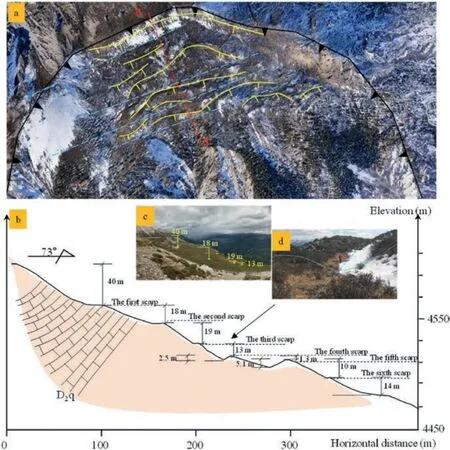
Fig.9.Images and photos show the features of the landform in main deformation zone: (a) Image and floor plan of main deformation zone,(b) photos of scarps and grooves in main deformation zone,(c) the third scarp,and (d) longitudinal profile of main deformation zone.
(2) Karst zone
The process of karstification primarily occurs at elevations between 3900 m and 4400 m.Early karsts developed along structural planes and layers.During the development process of karstification,the soluble rock is chemically corroded by groundwater,and the weaker rocks have dissolved away,forming stone forests and stone walls (see Fig.10).The stone forests and stone walls exhibit heights of more than tens of meters.Over time,these formations have been subjected to weathering,unloading,freezing and thawing,leading to erosion and destruction.As a result,some of these features have transformed into mound-like shapes,particularly the shorter,scattered,and isolated stone forests.At present,the remnants of early karst peaks and forests can still be clearly observed from the surface survey.The surface underwater seepage still has the effect of dissolving and widening the cracks.Nevertheless,this dissolution is more concentrated on the rock mass structure below the erosion base level.
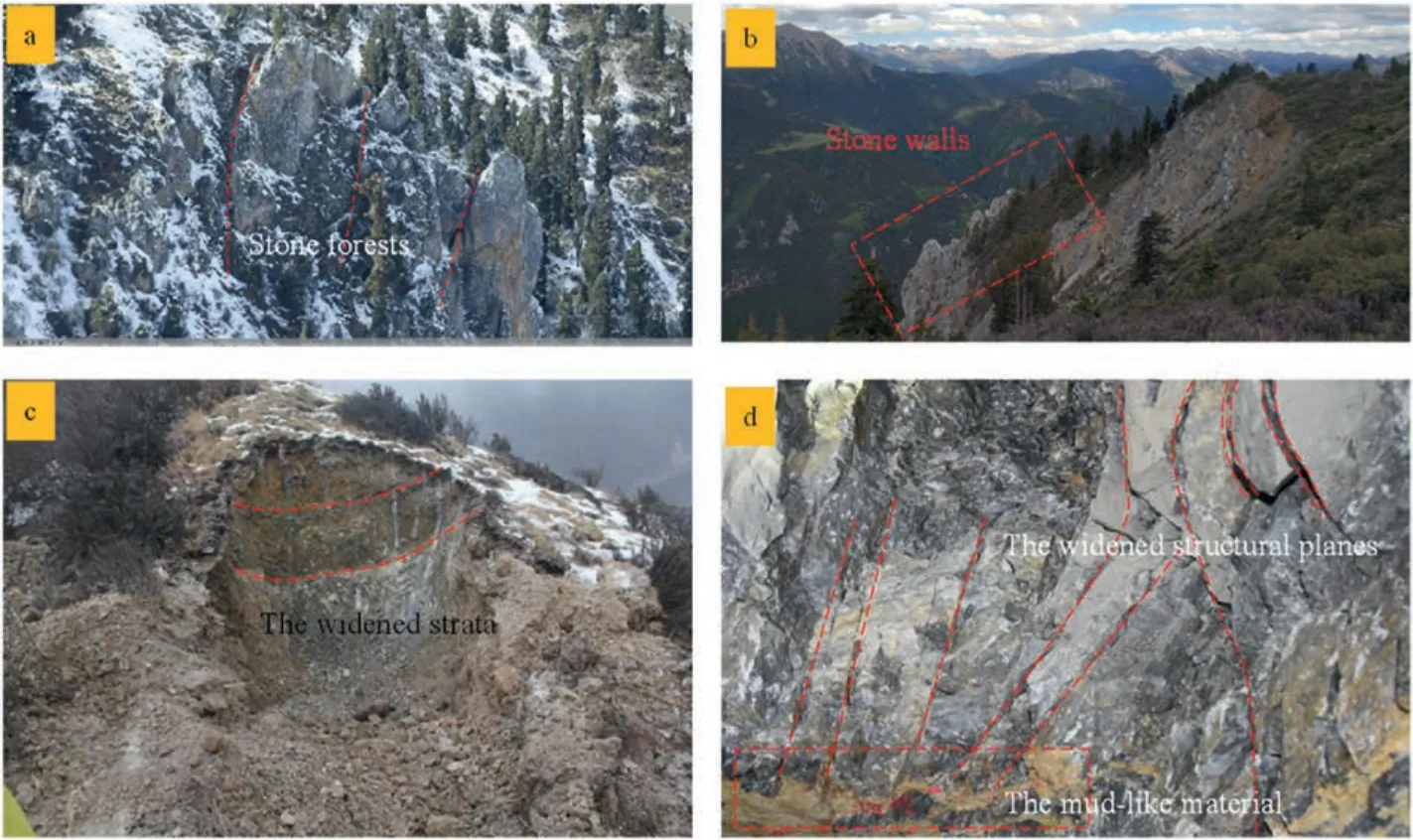
Fig.10.Images and photos show the features of the landform in karst zone: (a) Stone caused by karstification;(b) Stone walls caused by karstification;(c) The widened strata formed by karstification;and (d) The widened structural planes and the mud-like material formed by karstification.
The excavation of the trench at the rear edge of the slope exposed karst cracks and gray-green mud in the bedrock,which are associated with bauxite minerals and indicate a closed environment.At adit PDG01,located at an elevation of 3650 m,early karst cracks are observed in some sections.Analysis of twenty-four dissolution cracks within a 200 m range reveals that these cracks typically open between 0.5 cm and 2 cm,with a maximum width of 5 cm.The cracks exhibit grayish-yellow rock blocks,cuttings,and a calcium film,among other characteristics.The dissolution cracks are characterized by three-wall penetration and undulating roughness inside the adit.At present,groundwater in the adit is not developed,and there is a lack of new conditions for the development of karst cracks because the erosion base level of the Jiangqu River has dropped significantly.
(3) Superficial deformation zone
For the slope area below the 3600 m elevation range,the average slope angle is approximately 35°.The terrain is slightly undulating in this zone,and the surface vegetation is dense and dominated by perennial trees.There are many gullies on the slope surface,with different depths up to tens of meters deep,and the rock mass exposed on the sidewalls of the gullies has good integrity(see Fig.11).According to the investigations,the scenario of saber trees appeared sporadically in this zone,which was caused by the partial slippage of the shallow overburden of the slope surface.The foot of the slope is affected by the scouring of the Jiangqu River,and there are many slippery and slumping scenarios on the slope surface.The slumping surface has a width of 10-60 m and a height of 30-50 m.In addition,it is affected by the erosion of the surface water flow,forming a river-across scouring gully.For instance,a groove developed on the downstream side of a slope,with a width of 10-20 m,is a seasonal gully.
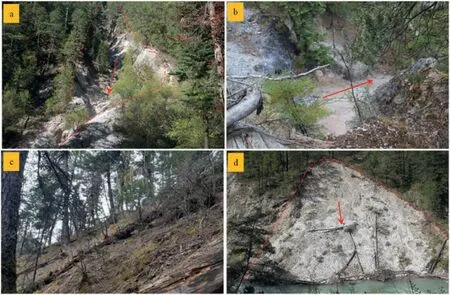
Fig.11.Photos show the features of some landforms in superficial deformation zone:(a,b)Gullies developed on the slope surface;(c)Sabre tree on the slope surface;and(d)Smallscale superficial landslide at the foot of the slope.
4.1.2.Historical deformation analysis based on remote sensing
Remote sensing images from four different time periods were used for comparison,and the data sources and timings were described in the previous section.The chair-shaped terrain and the scarps of the trailing edge are presented in Fig.12a.During these four periods,there was no obvious continuous deformation of the slope as a whole and the river channel at the foot of the slope showed almost no signs of being squeezed or diverted.The image shows that the superficial damage in the karst area has continued to develop on the surface of the slope,and that the exposed area of gray-white rock increased in size.To assess the presence of continuous overall deformation on the slope,specific regions along the back wall were selected,and the changes in their respective areas were analyzed.These areas include the one indicated by A-A′on the right side of the back wall,the ones B-B′,D-D′,and E-E′on the rear side of the back wall,and one C-C′on the left side of the rear edge.Statistical analysis indicates that although there is a gradual increase in size for these areas along the back wall of the slope,the observed changes are relatively small (see Fig.13).
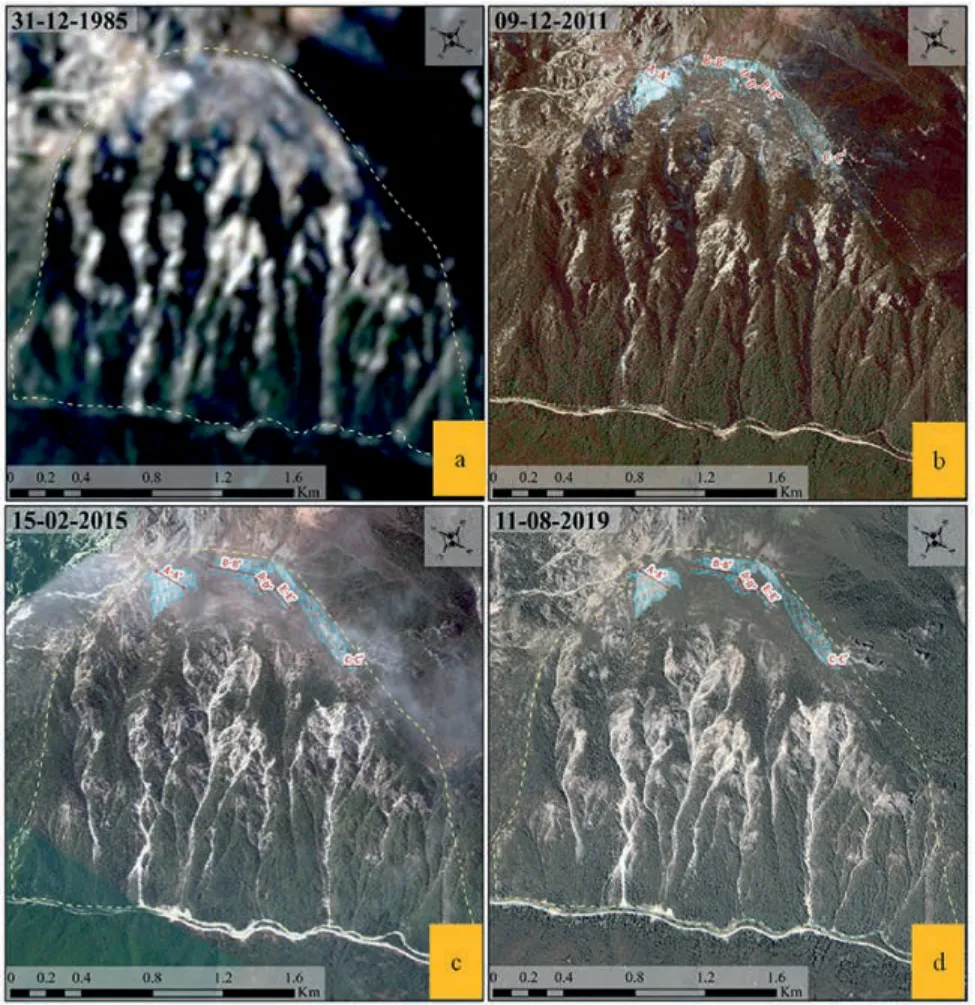
Fig.12.Remote sensing images from four periods: (a)Shot on December 31,1985;(b)Shot on December 9,2011;(c) Shot on February 15,2015;and (d) Shot on August 11,2019,from GF-2 satellites.
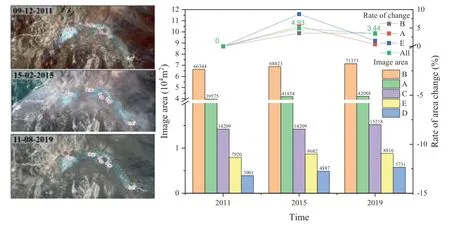
Fig.13.The area change-rate of remote sensing images from four periods.
4.1.3.Surface deformation analysis based on InSAR
The SBAS-InSAR time series analysis based on Sentinel-1 data is used to analyze the slope surface deformation.The acquisition time is from November 2017 to November 2020.The result shows that there is no obvious deformation of the slope (see Fig.14).

Fig.14.The SBAS-InSAR time series analysis based on Sentinel-1 data: (a) Result of SBAS-InSAR and (b) image from GF-2 satellites at the same position.
In conclusion,the JRS displays typical features of a landslide landform.Persistent deformation was not detected through SBASInSAR analysis.Remote sensing images indicate the development of surface deformation in the karst areas of the slope,and the area of the back wall has shown continued growth.However,it should be noted that comprehensive remote sensing primarily considers surface and geomorphic characteristics,limiting its ability to assess internal conditions.Therefore,based on comprehensive remote sensing alone,it cannot definitively determine that the slope is not a potential landslide.
4.2.Potential failure modes
The joint cracks that developed on the JRS can be divided into primary joints and unloading cracks according to the genetic types.The primary joints are dominated by planes,and the planes are anti-dip and steep (N20°-50°W/SW∠55°-70°).Unloading cracks are mainly manifested as tensile cracks that are parallel to the bank slopes and inclined outside the slope.The trend of cracks is mainly NW.Based on survey results of joint cracks by adit and slope surface,the following five groups of joint cracks are observed (see Fig.15).Joint crack group J1 was with the occurrence of N35°-60°W/NE∠71°-88°,and the extension greater than 2 m.The surface of J1 was rough,and the degree of weathering was mild to moderate rust staining.The opening of most cracks ranges from 0.1 cm to 0.5 cm,with some openings measuring between 1 cm and 5 cm.The occurrence of J2 is N70°-80°E/NW∠50°-60°,and these joint cracks extend more than 2 m.The surface is rough,and part of the structure surface forms step ridges.The degree of weathering was slight to moderate rust staining,with openings of 0-0.3 cm.The occurrence of J3 is E-W/N∠80°-90°,and these joint cracks extend 2-3 m.The surface is straight-undulating and rough,and the degree of weathering shows a mild-medium degree of rust staining,with openings of 0-0.3 cm.The occurrence of J4 is N5°-20°E(W)/NW(SW)∠35°-50°,and the extension of these joint cracks is more than 2 m.The surface is rough,and the degree of weathering is light-moderate rust staining,with openings of 0.1-0.5 cm.The occurrence of J5 was N5°-20°E(W)/NW(SW)∠60°-85°,and these joint cracks extended more than 2 m.The surface was rough,and the degree of weathering was mild-moderate rust staining,with openings of 0.1-0.5 cm.

Fig.15.Dominant joints and cracks that are developed on the JRS: (a) Images of the structural planes (J1,J2,J4);(b) Image of the strata;(c) Photo of the strata and the structural planes (J3,J5);(d) Image of the strata and the structural planes (J3,J5);and (e) Contour diagram of poles for the main joints and cracks in the JRS.
It can be observed that all dominant structural planes of the JRS intersect with the slope direction at a significant angle,except for group J1 as shown in Fig.15e.The inclination angles of all joint cracks,including group J1,are primarily medium to steep.This indicates that the two-by-two combination of superior structural surfaces does not provide a suitable sliding surface for plane sliding.Therefore,the failure mode can be considered as toppling failure.Based on L1-L4 in Fig.8b,four shallow sliding surfaces(H1-H4)are identified based on the unstable sliding of the upper levels.Additionally,the H5 slip surface is defined by considering the creep deformation of the deeper layer,as shown in the schematic diagram in Fig.16.

Fig.16.Sketch map of potential sliding mode: (a) Four shallow sliding surfaces H1-H4,and (b) H5 slip surface considering deep creep.
4.3.Further judgment based on comprehensive geology
4.3.1.Potential failure mode determination considering rock mass structure
Toppling failure is a common and serious instability scenario in both natural and artificial rock slopes (Tu and Deng,2020).The toppling fracture mechanism has been studied at numerous sites,including road-cut slopes,hydropower high rock slopes,open pits,and natural steep slopes(e.g.De Freitas and Watters,1973;Wyllie,1980;Caine,1982;Woodward,1988;Cruden et al.,1993;Tamrakar et al.,2002).
Toppling failure models can be divided into two main categories(see Fig.17).Bending-overturning-toppling failure typically occurs in soft rock slopes with high plasticity.The deformation process is slow and tends to stabilize gradually.Several examples of such failures include the Laxiwaguobu bank slope,the Miaowei Hydropower Station dam abutment slope,the slope of the diversion ditch of the Xiaowan Hydropower Station,the bank slope of the Santan section of Jinping I,the Huangdeng Hydropower Station#1 and#2 dumping bodies,and the Yalong River Hydrological Station.In contrast,massive toppling failure usually occurs in brittle hard rock slopes,and the deformation is relatively large.This type of failure can quickly develop into a catastrophic landslide.
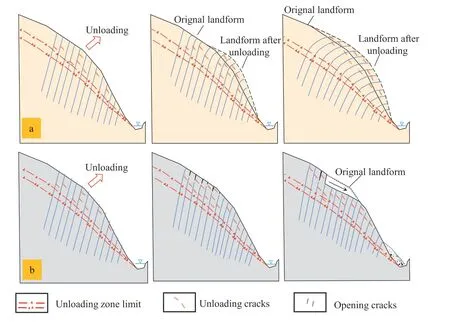
Fig.17.Two typical slope toppling failure modes: (a) Bending-overturning-toppling failure,and (b) massive toppling failure.
Previous studies have shown that most toppling fractures occur in the near-surface and shallow rock mass of slopes with a thickness of tens of meters (Zhang et al.,2015;Gu and Huang,2016).However,in recent years,numerous cases of deep-seated toppling fractures with distances to the slope surface of 200-300 m have been recorded in Southwest China(Qi et al.,2004;Huang,2012;Tu and Deng,2020).Large-scale toppling failures in deep valleys typically undergo a prolonged incubation period and exhibit two distinct characteristics:significant variations in the dip angle of the strata and division of the deep-seated toppling rock mass into four zones,i.e.rock creep deformation zone,intense toppling zone,weak toppling zone,and parent rock zone,from the outer to the inner parts of the slope.However,the JRS slope does not display these typical characteristics.On the JRS,the deformation and failure of the upper part of the slope are mainly multilevel scarps and grooves at the rear of the scarps,which can easily be judged as evidence of potential landslides.
The slope surface bedrock layer survey was carried out from an elevation of 4470 m on the top of the slope to an elevation of 3200 m on the left bank of the Jiangqu River.The survey results show that the steep slope is 205°-285°.In the slope body,the inclination angle is generally 55°-70°.There is no consistent trend of occurrence in the slope rock formation from top to bottom,and the overall rock formation of the slope does not exhibit a characteristic tipping deformation,as depicted in Table 4 and Fig.18a.

Table 4 The statistical table of the occurrence of the rock formation exposed on the slope surface with elevation change.
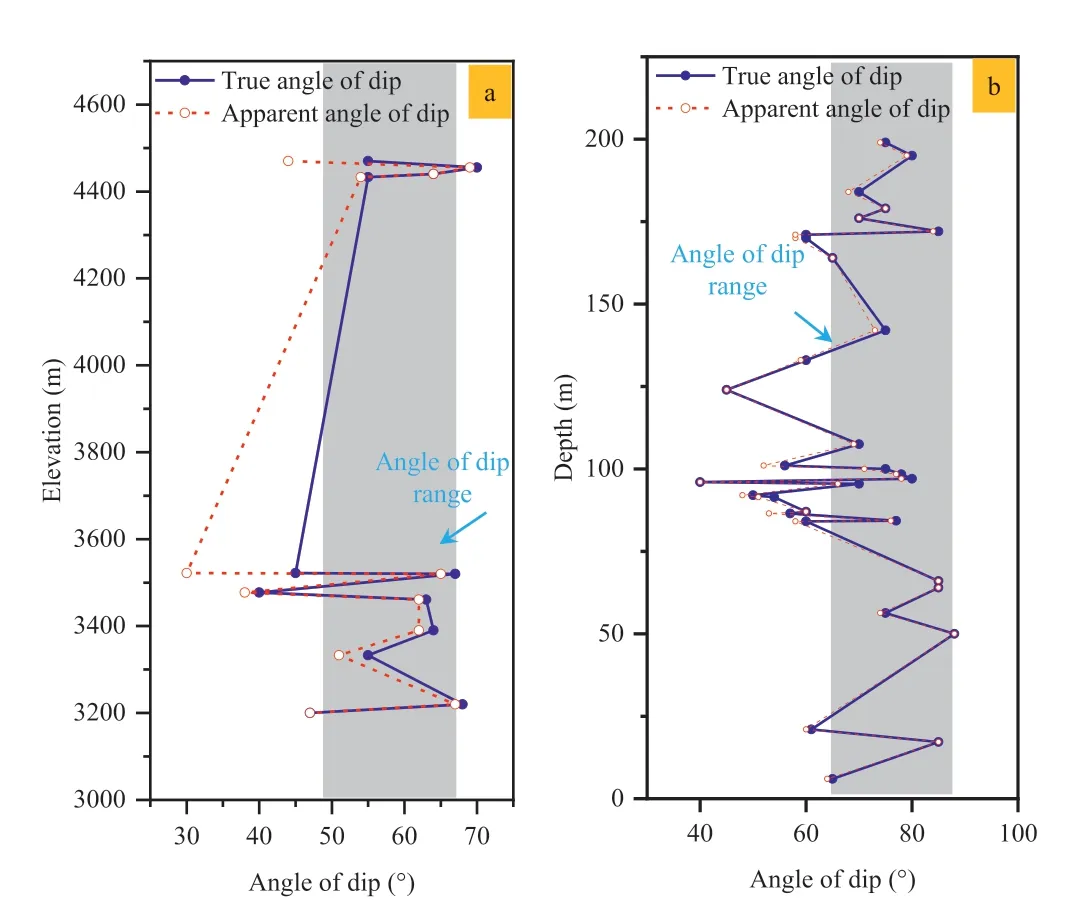
Fig.18.(a)The statistical graph of the rock formation occurrence exposed on the slope surface with elevation change,and (b) Statistical diagram of the rock formation occurrence with horizontal burial depth changes (according to the statistical data in adit PDG01).
The 200 m range within adit PDG01 with an elevation of 3650 m reveals that the occurrences of massive marbled limestone formations are consistent.In the inclined slope,the inclination angle is generally 60°-75°,and there is no sign of rock layer dumping in the 200 m range of the slope.The inclination angle of the structural surface of the anti-dip slope in exploration PDG01 do not varies with the depth of the cave,as shown in Table 5 and Fig.18b.
Based on the occurrence of the underlying bedrock layers observed in exploration trenches TC-03 and TC-04,as well as the geological conditions identified through planar geological survey lithology points,there is no clear correlation between the increase in slope of the JRS and elevation.Furthermore,the inclination angle of the structural surface in the flat exploration tunnel of the antidip slope do not varies with the cave depth,and there is no discernible pattern of uniformity.Considering the available deep geophysical data,it can be concluded that the current slope generally does not exhibit overall toppling deformation characteristics.The rock mass exposed on the slope has good integrity and relatively high strength and does not have the conditions for toppling deformation.Hence,the presence of reverse slope scarps on the upper portions of the JRS largely eliminates the possibility of overall slope collapse.
4.3.2.Geomorphological evolution analysis considering geological history
On the JRS,the deformation and failure of the upper part of the slope are mainly multilevel scarps and grooves at the rear of the scarps,which can easily be judged as evidence of potential landslides.Based on previous research results on the landform evolution history of the Western Sichuan Plateau Plateau(e.g.Arne et al.,1997;Xu and Kamp,2000;Kirby et al.,2002)and our field survey of the slope landform,the historical evolution process of the JRS were summarized from a geological age perspective.
The JRS is located in the Sichuan-Tibet alpine valley area,which is one of the six major components of the Qinghai-Tibet Plateau.The general elevation ranges from 3000 m to 5000 m with an average elevation over 4000 m.According to earlier research findings (e.g.Dai and Deng,2020),the study area witnessed the deposition of multiple carbonate layers from the Paleozoic to the Early Cenozoic.These carbonate formations generally exhibit an east-west trend and are distributed in strip-like patterns.The Late Miocene tectonic activity exerted significant influence,resulting in pronounced folding and faulting in the region.During periods of crustal stability,extensive karstification took place,giving rise to large-scale karst scenarios.Localized karst collapses occurred,leading to the formation of weak areas.The ongoing strong and continuous uplift movement since the Quaternary period has caused the climate to become dry and cold,which has not favored surface karst development.Subsequently,the karstification mainly occurred underground with only a small number of dissolution cracks and karst springs developing on the surface.Especially since the Middle Pleistocene,the exposed bedrock with weak weathering and fresher conditions underwent differential weathering due to varying anti-dissolution capabilities of limestone,mudstone,and dolomite under long-term dissolution and weathering.Limestone and marl bands with low dissolution capacity were more likely to be taken away by dissolution,while dolomites with high dissolution resistance are mostly retained.
The period from the quasi-wide valley to the broad valley(around 100,000-500,000 years ago)corresponds to the secondary planation phase (4100-4600 m) of the Western Sichuan Plateau,which was formed during the Early Pleistocene.During this period,the river downcutting rate was relatively slow and lasted for an extended duration.Following the disintegration of the peneplain,the slope experienced significant deformation.Failure modes during this period may have included sliding failure along the outer or nearly horizontal structural surface of gently inclined slopes,sliding-bending failure along steeply inclined structural surfaces,or toppling failure of shallow surfaces.According to the characteristics of the anti-dip slopes of the rock formations in this area and the extension and distribution of the regional long structural planes(J4:N5°-20°E(W)/NW(SW)∠35°-50°,J5:N5°-20°E(W)/NW(SW)∠60°-85°),it is inferred that local failure geological events with sliding and toppling properties occurred at elevations above approximately 4100 m(see Fig.19a).During this period,the neotectonic movements in the region were active and strong earthquakes occurred frequently,leading to strong karstification before the Neogene and the formation of karst caves,karst trenches and troughs from differential dissolution.The deformation and destruction of the slope were caused by the overall collapse and subsequent collapse of the stone walls.Following the collapse,a multilevel grooved landform was initially formed (see Fig.19B).Subsequent weathering,glaciation,denudation,karstification,and freezing and thawing processes further shaped the landform into a grooved and gently undulating slope (see Fig.19c).
During the Late Pleistocene,the river experienced a period of rapid downcutting,leading to a drop in the erosion base level.As a result,the karst development in the upper part ceased.The only visible features were dissolution fissures below the groundwater erosion base level and the presence of karst springs along these fissures.These springs were only exposed at approximately 170 m-240 m downstream of Huolong ditch and exhibited characteristics of descending springs.Below elevation of 4200 m,the slope shape was smooth and relatively complete.The cracks were mainly of weathered unloading cracks.The shallow surface collapses or collapses locally by erosion due to seasonal rainfall,and there is no excessive deformation or failure (see Fig.19d and e).This observation is supported by the absence of prominent undulations and gentle slope platforms on the side slopes,as well as the shallow and limited coverage of modern riverbeds and slope toes.Conversely,if rapid deformation and failure occurred above an elevation of 4400 m,or if large-scale instability failure occurred below this elevation,the accumulated instability would undoubtedly be evident at the foot of the slope and in the modern riverbed,resulting in a significant depth of overburden.In addition,it would even block the Jiangqu River,including large unstable slopes on both sides of the Jiangqu River in the area,and the front edge of the river would be squeezed.Therefore,the deformation of the trailing edge of the slope must occur before the formation of the leadingedge slope.
The Pleistocene in the Quaternary Period was also a period of widespread glaciers.The area was also covered by glaciers(An et al.,2001;Lehmkuhl and Owen,2005;Zhou et al.,2010;Heyman et al.,2011;Kirchner et al.,2011;Wang et al.,2013,2015;Xu,2014) (see Fig.19c).Therefore,the area would have inevitably been influenced by glacier activity.Due to the transformation of intense external geological processes over time,glacial landforms and accumulations have been subjected to varying degrees of erosion and are now largely unrecognizable or destroyed.However,numerous“U”-shaped ice-eroded troughs can still be observed in the region at altitudes of 4200-4800 m,forming a distinct “L”-shape.Specifically,the troughs initially trended northward in the early period and later shifted to an eastward direction (see Fig.19f).It is speculated that the region was strongly structured in the middle Pleistocene.Similarly,the top of the JRS underwent violent ice erosion to the north during the early-middle Pleistocene,and ice erosion troughs and valleys may also have formed at the early stage at the top ramp of the slope (see Fig.19c).The sources of material are all on the south and west sides,which are also verification points.Therefore,the initial formation of the complex topography of the moraine floor(see Fig.19b)led to the development of a fanshaped landform as it became covered by numerous glacial moraines.The moraine floor’s intricate composition resulted in variations in the thickness of the cover.As the river valley continued its downcutting process,the ice tongues suspended at the tops of the four main troughs were pulled downward by gravity,resulting in the formation of multilevel scarps with varying heights.The overlying material lacks schistosity,but distinct,rounded glacial debris can be observed (see Fig.19g).
4.4.Numerical analysis of aging stability
4.4.1.Current stability
The stability factor of the current slope,calculated using the strength reduction method,is determined to be 1.27.When considering this factor,the potential failure area and potential sliding surface of the slope are depicted in Fig.20.The potential failure occurs predominantly in tension,while the potential shear failure area is situated along the potential shearing out position of the slope,specifically between elevations of 4000-4150 m and 3700-3800 m.Additionally,a portion of the potential failure area is observed at the foot of the slope due to the presence of a fault and unloading effects.There are two potential sliding surfaces,the first shallow sliding surface is about 50 m deep with shearing out at elevations 3900 m and 3700 m(see Fig.20b and c),and the second potential sliding surface is about 160 m deep with shearing out at elevation 3600 m (see Fig.20c).There are multiple levels of potential fracture surfaces at the back edge of the slope(see Fig.20a),and the potential instability mode of the slope is high instabilitysliding mode,and their potential damage ranges are all located above the elevation of 3600 m.
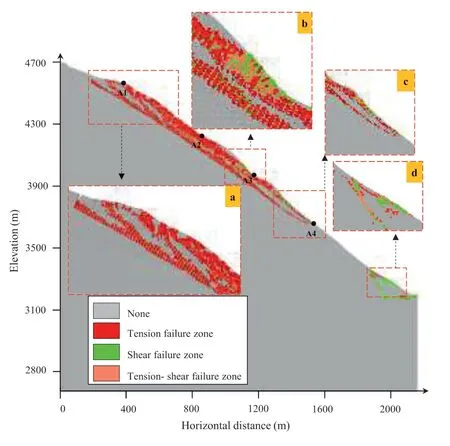
Fig.20.State diagram of the damage zone of the slope when the discount factor Ks=1.27:(a)Multiple levels of potential fracture surfaces at the back edge of the slope;(b) Shearing out location of shallow sliding surfaces;(c)Shearing out position of deep sliding surface;and (d) Area affected by fracture at the foot of the slope.
4.4.2.Aging stability
The aging stability calculation is conducted on the timedependent mechanics results,primarily considering the selfweight effect.Creep calculations are performed for various time durations,including 10,20,30,50,70,and 100 years.The model,corresponding to each creep duration,is subjected to a strength reduction calculation to determine the stability factors.Additionally,four monitoring points(A1,A2,A3,A4)are established on the slope surface to track the horizontal displacement(see Fig.20).The total horizontal displacements of the monitoring points and the stability factors under different creep durations are computed and presented in Fig.21.

Fig.21.Calculation results of aging stability: (a) The total horizontal displacement of each monitoring point,and (b) Elapsed time versus total horizontal displacement curve.
As illustrated in Fig.18a,the total horizontal displacement of each monitoring point remains stable when the stability factor exceeds 1.1.When the stability factor falls between 1.05 and 1.1,indicating a weak deformation stage,the slope deformation begins to increase.A significant increase in slope deformation is observed when the stability factor ranges between 1.03 and 1.05,representing a strong deformation stage.In practical conditions,the stability factor of the slope decreases as deformation progresses,resulting in a continuous change over time.Consequently,the simulation results enable the plotting of a time-displacement curve for the monitoring point,as depicted in Fig.21b.Analysis of Fig.21b reveals that the total deformation amount corresponding to the monitoring points remains constant when the stability factor ranges from 1.25 to 1.08.When the stability factor exceeds 1.08,the slope enters a stable creep stage characterized by a leveling off creep deformation,resulting in a stable macroscopic slope deformation.Conversely,when the stability factor falls below 1.08,the displacement of the monitoring point increases significantly,indicating that the slope enters a stage of accelerated deformation where the creep curve fails to reach a stable state.Notably,when the stability factor reaches 1.03,a significant change in the total horizontal deformation amount of the monitoring point occurs,with the appearance of an inflection point in the curve depicted in Fig.19b.It indicates that creep years need to exceed 80 years for slope deformation to intensify and then form a high level of shallow sliding.Combining the geomorphic features with the stability calculation results,the slope is considered to be a stable slope with landslide geomorphology.
5.Discussion
The advancement of satellite remote sensing technology has led to the widespread adoption of various techniques such as optical remote sensing,LiDAR,InSAR,TLS,and UAV for geohazard identification.These methods have gained significant momentum and have rapidly evolved in recent years(Ferretti et al.,2000;Berardino et al.,2002;Zhang et al.,2012;Hsieh et al.,2016;Mateos et al.,2017;Jia et al.,2019;Li et al.,2020;Xie et al.,2022).The current geomorphological features are frequently considered as the key point that best characterizes whether a slope is a potential landslide.Geomorphological features,especially the chair-shaped terrain and the cracks and scarps generated on the trailing edge,are the most commonly used landslide identification evidence when using remote sensing images to identify landslides.The presence of landslide geomorphological features frequently leads to the assumption that slopes are more likely to be potential landslides,in contrast to slopes without such features.This judgment method is typically effective in areas where the geomorphological causes are straightforward and influenced by single factors (Scaioni et al.,2014;Fan et al.,2017;Intrieri et al.,2018;Ouyang et al.,2018;Li et al.,2019).However,the Qinghai-TibetPlateau is an area with complex geological environment and strong tectonic activities.The formation of the landform is affected by strong tectonic effects such as glaciers,freeze-thaw,karst,weathering,and unloading,etc.,instead of being solely affected by the erosion of river.Numerous slopes exhibiting landslide geomorphology are primarily shaped by intricate external conditions,yet they remain stable slopes rather than potential landslides.The JRS investigated in this study exemplifies a stable slope with landslide geomorphology,and similar examples abound across the Qinghai-Tibet Plateau.
While features like chair-shaped terrain,presence of cracks,and scarps on the trailing edge are frequently associated with landslide geomorphology,it is important to note that their presence does not guarantee the classification of a slope as a potential landslide.Conversely,slopes that do have the potential for landslides may not exhibit the characteristic chair-shaped terrain or prominent cracks and scarps on the trailing edge.In their study on the history of deformation of large-scale rock landslides and its implications,Li et al.(2019) highlighted that the presence and development of trailing edge cracks and front edge slumping varied in different types of landslides.For bedding landslides such as Yingping Village landslide and Xinmo Village landslide(Fan et al.,2017;Intrieri et al.,2018),the deformation process did not exhibit significant trailing edge crack development and front edge slumping.In contrast,for anti-dipping landslides like Pusa Village landslide and magmatic rock landslides such as Su Village landslide and Baige landslide(Ouyang et al.,2018),the trailing edge cracks extended continuously until closure,while the front edge deformation primarily involved increasing-scale collapses,indicating a coordinated deformation pattern.As for the JRS,the trailing edge is historically deformed which is caused by glaciers,freeze-thaw,karst,weathering and unloading,and the leading edge does not have a coordinated deformation.It is easy to consider JRS as a potential landslide without distinguishing its deformation history through the analysis of evolution history.It can be seen that a slope with landslide geomorphology is not necessarily a potential landslide,and a potential landslide does not necessarily have the typical features of a landslide.
Hence,this study employs a process-oriented method that incorporates the concept of time-dependent evolution to assess the potential landslide status of the slope.Unlike the remote sensing approach that primarily relies on geomorphic features,this method recognizes the significance of considering the temporal aspect in evaluation.In the quantitative calculation phase,a time-dependent stability assessment method is introduced,which encompasses time-dependent mechanical calculations and strength reduction analyses tailored for anticline slopes.This method,in contrast to the remote sensing approach,underscores the crucial role of timedependent evolution and facilitates a comprehensive process encompassing qualitative analysis and quantitative calculation.
However,there are still limitations in the quantitative calculation part that may lead to less accurate calculation results.When considering the strain-softening process in the model,it is simplified to the process of linear variation of strength with strain(Wang and Zhao,2016),which is different from the actual variation process,thus the corresponding rheological intrinsic model needs further improvement.In the simulation calculation,the model was simplified by considering the optimization of calculation speed,and only the influence of the layers was considered,without considering the influence of factors such as the joints surface.The 3D stability accnalysis based on the actual survey results is more reasonable and closer to the actual situation,which is also worth exploring.In the analysis of aging stability,a stepwise reduction of strength parameters is conducted,leading to the derivation of a new set of discounted strength values.Subsequently,numerical calculations are performed to gradually approach the limit equilibrium state of the slope.The coefficient of reduction achieved at this stage is considered as the stability coefficient.However,in the process of slope failure,there are differences in the degree and speed of decay of cohesion and internal friction angle.Therefore,the experimental study on the weakening law of cohesion and internal friction angle may reflect more accurately the real trend of aging stability of slopes.
The whole process method emphasizes the importance of timedependent evolution more than the conventional method,and also incorporates the quantitative calculation part,thus avoiding the over-emphasis on the geomorphological features.However,the method is only applied to the JRS with landslide features,which is located on the Tibetan Plateau.
6.Conclusions
The JRS,a controlled slope located on the Qinghai-Tibet Plateau,exhibits characteristic geomorphological features commonly associated with landslides.Recognizing the limitations of relying solely on remote sensing methods for landslide identification,a processoriented method considering time-dependent evolution was employed to assess the potential for landslide occurrence.The findings of this study are summarized as follows:
(1) The geomorphological features are frequently considered the most direct evidence of landslides.Nevertheless,excessive emphasis on geomorphological features will result in misjudgment.The combined method of comprehensive remote sensing,geology,and numerical analysis is a process from qualitative analysis to quantitative calculation.Within this framework,the concept of time-dependent evolution is central to the analysis and calculation of aging stability,providing a deeper understanding of the historical evolution of the slope.By utilizing this method,the potential misjudgment associated with remote sensing methods that overly emphasize geomorphological features can be effectively mitigated.
(2) The comprehensive remote sensing analysis by UAV,remote sensing and InSAR indicates that JRS may be a potential landslide.This study has identified and proposed two potential instability modes based on geomorphological features.However,the comprehensive geology analysis,conducted through historical evolution analysis and rock structure analysis,refutes the possibility of these two instability modes.In contrast,the numerical analysis provides quantitative support for the slope’s stability by evaluating both the current stability and aging stability.The results indicate that creep slopes would require more than 80 years to potentially exhibit shallow sliding.
(3) The JRS is considered to be a stable anti-dip slope with typical landslide landforms rather than a potential largescale rocky landslide.Its distinctive geomorphological features,resembling those of landslides,are the characteristic and representative of the entire Qinghai-Tibet Plateau and other deep incline valley regions.This work provides insights into the geomorphological characterization and evolution history of the JRS,as well as useful inspiration for the study of other slopes with similar landslide geomorphology.
Declaration of competing interest
The authors declare that they have no known competing financial interests or personal relationships that could have appeared to influence the work reported in this paper.
Acknowledgments
This research was supported by the National Natural Science Foundation of China (Grant Nos.41972284 and 42090054).This work was also supported by the State Key Laboratory of Geohazard Prevention and Geoenvironment Protection Independent Research Project (Grant No.SKLGP2020Z005).
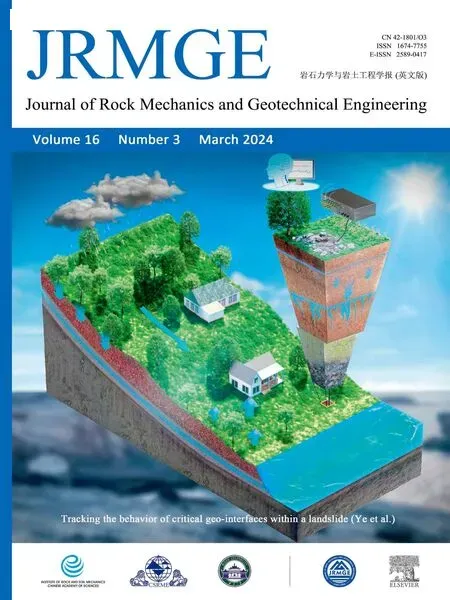 Journal of Rock Mechanics and Geotechnical Engineering2024年3期
Journal of Rock Mechanics and Geotechnical Engineering2024年3期
- Journal of Rock Mechanics and Geotechnical Engineering的其它文章
- Limit load and failure mechanisms of a vertical Hoek-Brown rock slope
- Limit state analysis of rigid retaining structures against seismically induced passive failure in heterogeneous soils
- Bearing capacity of circular footings on multi-layered sand-waste tire shreds reinforced with geogrids
- Experimental investigation on the permeability of gap-graded soil due to horizontal suffusion considering boundary effect
- Damage constitutive model of lunar soil simulant geopolymer under impact loading
- Wetting-drying effect on the strength and microstructure of cementphosphogypsum stabilized soils
